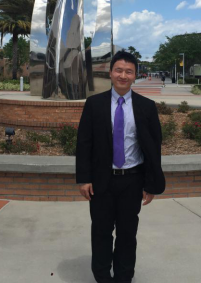主讲主题1:Rutting evaluation of full depth flexible pavement using full scale accelerated pavement testing
主讲人:田雨
主讲人照片:

时间:2017年05月12日周五09:30-09:50
地点:交通运输工程学院103会议室
主讲人简介
Dr. Yu Tian is a research scientist in the school of civil engineering at Purdue University. His research focuses on the mechanistic-empirical pavement design, accelerated pavement testing techniques, pavement preservation and nondestructive evaluation methods. Dr. Tian is member of International Society for Asphalt Pavements (ISAP) and American Society of Civil Engineers (ASCE). Dr. Tian is an author of 9 scientific journal articles and 4 copyrighted software, inventor of 3 patents, and awardee of William and Mary Goetz Graduate Fellowship, “Wuhan City Partner”, “Wuhan City: Huanghe Talents Plan”, “MOHRSS: Funding Scheme to Outstanding Scientific and Technological Programs by Chinese Students Abroad”. Dr. Tian holds bachelor degree in civil engineering from Huangzhong University of Science and Technology in China, master and doctor degrees in civil engineering from Purdue University in the united states.
主讲内容简介
A prototype full-scale Accelerated Pavement Testing (APT) facility was designed and built by Purdue University and the Indiana Department of Transportation. This study presents the development of a new mid-depth profile monitoring system (MPMS) to investigate the rutting behavior of full-depth asphalt pavements. The scope incorporates an experimental study that uses a full-scale accelerated pavement testing (APT) facility. Two different thicknesses of full-depth asphalt pavements were constructed in the Indiana accelerated pavement-testing facility. A laser profile scanning system was designed to reconstruct the transverse profiles at each pavement layer interface throughout the process of accelerated pavement deterioration. The contribution of each pavement structural layer to the total rut depth and the evolution of layer deformation were determined. The developed system provides reasonable results with a high accuracy level based on the findings. First, the measured rutting curves at each layer interface agree well with the theoretical characteristics of rutting evolution and clearly exhibit the primary and secondary stages of rutting development. Second, the locations of critical rutting and the total rut depths were found to be independent of pavement thickness when the pavement is sufficiently thick, which is a finding that agrees with previous study results. The results demonstrate MPMS developed in this study provides an excellent method to evaluate the rutting performance of asphalt pavements in the APT. In addition, MPMS has a potential application to in-service pavements.
主讲主题2:Comparison of Laboratory and Field Asphalt Aging Using Polymer Modified and Warm Mix Asphalt Binders
主讲人:张伟光博士
主讲人照片:

时间:2017年05月12日周五09:50-10:10
地点:交通运输工程学院103会议室
主讲人简介
Dr. Weiguang Zhang is a Post-doc Research Assistant from School of Civil Engineering at Purdue University in West Lafayette. He is an active member of IACIP, ASCE, and AAPT. Dr. Zhang has led or participated 8 projects funded by NSFC, NCHRP, FDOT, INDOT, WADOT, and PSU. His research areas include materials, design, and performance evaluation of highway and airport pavements. He is co-author of the NCHRP report 843. He has also published 13 journals, 5 proceeding articles, 4 project reports, and given nine presentations at conferences and workshops such as TRB and ETG. Since 2015, Dr. Zhang has reviewed more than 50 papers for ASCE journals, TRR, Journal of Testing and Evaluation, Journal of Construction and Building Materials and TRB annual meeting. He was also a reviewer of NCHRP IDEA (2016) AND NCHRP ballot (2017).
主讲内容简介
There are concerns on if the laboratory aging can fully represent field pavement aging especially when polymer modified asphalt (PMA) and warm mix asphalt (WMA) binders are used. In addition, the laboratory aging was developed based on SHRP binder tests (i.e., performance grade, PG); its applicability to recently developed tests such as MSCR is not clear. Therefore, the objectives of this paper are to investigate quantitatively the level of laboratory aging (both short-term and long-term) as compared to the field aging for both the control HMA binders and WMA/PMA binders, as well as to evaluate if the MSCR results using laboratory aged binders are comparable to the MSCR results based on recovered binders from field cores. Four projects that covered different climatic zones, pavement structures and materials were selected. Binder properties including high temperature PG, MSCR, binder low temperature PG and fracture energy are used for analysis. Based on the analysis, laboratory aging of asphalt binder is parameter sensitive: the laboratory RTFO and RTFO/PAV aging methods are insufficient to simulate field aging conditions for most cases except for low temperature PG test. Regarding MSCR test, no pattern can be found if the laboratory aging is sufficient/insufficient or reasonable to simulate field aging. Additionally, the Sasobit binders with PMA binders are over-aged by laboratory aging, thus the laboratory aging strength for such type of binder may need to be reduced to more accurately describe short-term field aging. Based on one mix type with non-polymer modified binders, 2 days’ oven aging of loose mix at 85°C matched well with the 1st-round recovered binders, indicating that 2-day oven aging of loose mix is reasonable to represent short-term field aging. Moreover, 7-day oven aging of loose mix is sufficient to mimic 3 years’ field aging.